Stocks Head into Seasonally Second Strongest Month of the Year
Stock-Markets / US Stock Markets Nov 30, 2008 - 06:13 PM GMTBy: Mike_Burk
 The good news is: New lows all but disappeared over the past week.
The good news is: New lows all but disappeared over the past week.
Short Term In an up trending market the down days give you the best information. We have not had a down day in the past week.
As of Friday's close the Russell 2000 (R2K) along with most of the major indices had been up for 5 consecutive days. From the late October low through Election day the R2K was up 21.8% in 6 consecutive days as of Friday's close it has been up 22.8% in 5 consecutive days, a discomforting similarity.
The chart below covers the past 2 years showing the R2K in red and an indicator showing the percentage of the past 6 trading days that were up in green. The indicator touches the top of the screen when there have been 6 consecutive up days and it touches the bottom of the screen when there have been 6 consecutive down days. Dashed vertical lines have been drawn on the 1st trading day of each month.

In the past year there have been 5 occurrences of 6 consecutive up days. Three of the 5 were followed by significant short term declines including the two in the past year. The market is overbought, if Monday is up we have a pattern remarkably similar to what we saw a month ago.
Intermediate term
Recently many indicators have seen record lows and/or record durations at extremely low levels. The charts below show the percentage of the component issues of the R2K and S&P 500 (SPX) that are above their 50 day EMA's. Both have held below 25% for about 2 months. The charts include every example of the indicators holding below 25% for a similar period.
The charts each cover a year, the exact dates are shown in the legend. The number following the dash after the date is the years position in the Presidential Cycle. Dashed vertical lines have been drawn on the 1st trading day of each month. The dashed vertical line is red on the 1st trading day of the year. Dashed horizontal lines have been drawn at the 25%, 50% and 75% levels for the indicator. The index has been drawn in red and the indicator in olive drab.
Past year, index = R2K
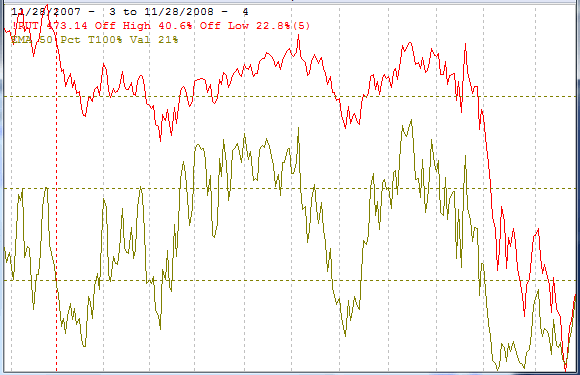
1998 low, index = R2K
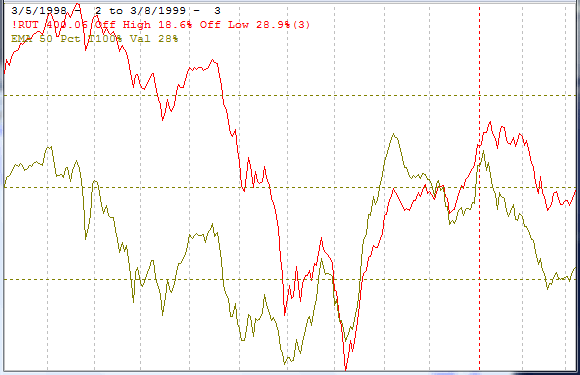
1994 low, Index = R2K
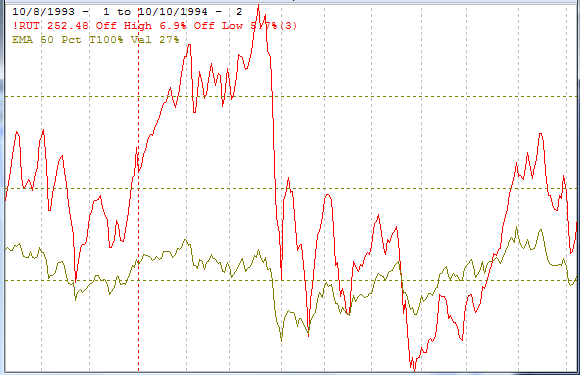
Past year, index = SPX
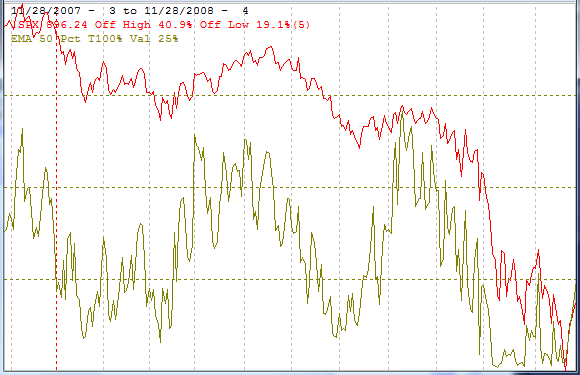
2002 low, index = SPX
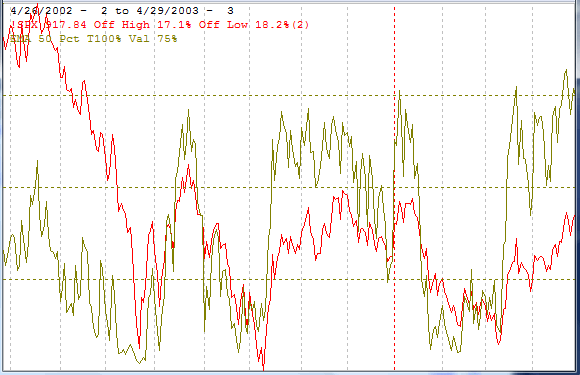
In the chart above the indicator was below 25% for 2 months during a retest of the low 5 months earlier. In the 1994 and 1998 examples with the R2K the indicator dropped below 25% briefly during the retest.
Currently the R2K indicator is at 21% and the SPX indicator is at 25% so it is too early to declare the currently prolonged period over. Even if it does end in the next week, a retest is likely.
Seasonality
Next week includes the 1st 5 trading days of December during the 4th year of the Presidential Cycle.
The tables show the daily return on a percentage basis for week of Thanksgiving during the 4th year of the Presidential Cycle. NASDAQ composite (OTC) data covers the period from 1963 - 2007 and SPX data from 1928 - 2007. There are summaries for both the 4th year of the Presidential Cycle and all years combined.
The averages, over all periods, have been modestly positive. The OTC's 6.39% gain in 2000 skews its average positively. The OTC was down on 3 of the 5 days in 2000 and ended with a gain of 6.39%.
The number following the year represents its position in the presidential cycle.
The number following the daily return represents the day of the week;
1 = Monday, 2 = Tuesday etc.
| OTC Presidential Year 4 | ||||||
| Day1 | Day2 | Day3 | Day4 | Day5 | Totals | |
| 1964-4 | -0.64% 2 | -0.82% 3 | 0.69% 4 | -0.02% 5 | 0.09% 1 | -0.70% |
| 1968-4 | 0.52% 1 | 1.75% 2 | 0.10% 4 | 0.24% 5 | -0.24% 1 | 2.37% |
| 1972-4 | 0.74% 5 | 0.15% 1 | 0.10% 2 | 0.30% 3 | 0.28% 4 | 1.57% |
| 1976-4 | 0.78% 3 | 0.01% 4 | 0.51% 5 | 0.35% 1 | 0.41% 2 | 2.06% |
| 1980-4 | -1.56% 1 | -0.59% 2 | 0.58% 3 | 0.63% 4 | -1.54% 5 | -2.47% |
| 1984-4 | -0.67% 1 | 0.02% 2 | -0.90% 3 | 0.12% 4 | -0.05% 5 | -1.48% |
| Avg | -0.04% | 0.27% | 0.08% | 0.33% | -0.23% | 0.41% |
| 1988-4 | 0.65% 4 | 0.01% 5 | 0.40% 1 | 0.42% 2 | -0.17% 3 | 1.32% |
| 1992-4 | 0.19% 2 | -0.16% 3 | 0.53% 4 | 0.80% 5 | 0.75% 1 | 2.10% |
| 1996-4 | 0.56% 1 | 0.05% 2 | -0.26% 3 | 0.24% 4 | -0.95% 5 | -0.37% |
| 2000-4 | 1.82% 5 | -1.12% 1 | 10.47% 2 | -3.23% 3 | -1.57% 4 | 6.39% |
| 2004-4 | 1.98% 3 | 0.25% 4 | 0.20% 5 | 0.15% 1 | -1.70% 2 | 0.88% |
| Avg | 1.04% | -0.19% | 2.27% | -0.32% | -0.73% | 2.06% |
| OTC summary for Presidential Year 4 1964 - 2004 | ||||||
| Averages | 0.40% | -0.04% | 1.13% | 0.00% | -0.43% | 1.06% |
| % Winners | 73% | 64% | 82% | 82% | 36% | 64% |
| MDD 12/7/2000 4.74% -- 12/5/1980 2.46% -- 12/7/2004 1.70% | ||||||
| OTC summary for all years 1963 - 2007 | ||||||
| Averages | 0.34% | 0.11% | 0.44% | 0.01% | -0.09% | 0.81% |
| % Winners | 64% | 62% | 69% | 56% | 47% | 60% |
| MDD 12/6/1974 7.53% -- 12/5/1975 5.18% -- 12/5/2002 4.99% | ||||||
| SPX Presidential Year 4 | ||||||
| Day1 | Day2 | Day3 | Day4 | Day5 | Totals | |
| 1928-4 | -1.03% 6 | -0.75% 1 | 0.25% 2 | -0.42% 3 | -3.78% 4 | -5.73% |
| 1932-4 | 2.75% 4 | -3.86% 5 | -0.15% 6 | 1.24% 1 | 5.05% 2 | 5.01% |
| 1936-4 | -0.81% 2 | -1.11% 3 | 0.53% 4 | -0.18% 5 | 0.12% 6 | -1.45% |
| 1940-4 | 0.09% 1 | -0.38% 2 | 0.00% 3 | -0.66% 4 | 0.19% 5 | -0.75% |
| 1944-4 | -0.23% 5 | 0.23% 6 | 0.62% 1 | 0.39% 2 | 0.00% 3 | 1.01% |
| Avg | 0.15% | -1.17% | 0.25% | 0.07% | 0.31% | -0.38% |
| 1948-4 | 1.76% 3 | -0.07% 4 | 0.87% 5 | 0.79% 6 | -0.13% 1 | 3.22% |
| 1952-4 | 0.08% 1 | 0.23% 2 | -0.12% 3 | -0.39% 4 | 0.04% 5 | -0.15% |
| 1956-4 | 2.00% 1 | -0.30% 2 | 1.20% 3 | 0.91% 4 | 0.49% 5 | 4.29% |
| 1960-4 | -0.43% 4 | 0.16% 5 | -0.14% 1 | 0.29% 2 | 0.99% 3 | 0.87% |
| 1964-4 | -1.03% 2 | 0.29% 3 | 0.47% 4 | 0.20% 5 | -0.02% 1 | -0.10% |
| Avg | 0.47% | 0.06% | 0.45% | 0.36% | 0.27% | 1.63% |
| 1968-4 | -0.23% 1 | -0.09% 2 | -0.32% 4 | 0.24% 5 | -0.25% 1 | -0.66% |
| 1972-4 | 0.61% 5 | 0.33% 1 | -0.16% 2 | 0.37% 3 | 0.50% 4 | 1.65% |
| 1976-4 | 0.38% 3 | -0.36% 4 | 0.63% 5 | 0.78% 1 | -0.07% 2 | 1.36% |
| 1980-4 | -2.36% 1 | -0.17% 2 | -0.19% 3 | -0.17% 4 | -1.80% 5 | -4.68% |
| 1984-4 | -0.46% 1 | 0.34% 2 | -0.78% 3 | 0.41% 4 | -0.31% 5 | -0.80% |
| Avg | -0.41% | 0.01% | -0.17% | 0.32% | -0.38% | -0.63% |
| 1988-4 | -0.44% 4 | -0.25% 5 | 1.15% 1 | 0.97% 2 | 0.19% 3 | 1.62% |
| 1992-4 | -0.13% 2 | -0.21% 3 | 0.00% 4 | 0.50% 5 | 0.75% 1 | 0.92% |
| 1996-4 | -0.06% 1 | -1.09% 2 | -0.42% 3 | -0.10% 4 | -0.64% 5 | -2.32% |
| 2000-4 | 0.02% 5 | 0.74% 1 | 3.89% 2 | -1.82% 3 | -0.59% 4 | 2.25% |
| 2004-4 | 1.50% 3 | -0.09% 4 | 0.07% 5 | -0.08% 1 | -1.11% 2 | 0.29% |
| Avg | 0.18% | -0.18% | 0.94% | -0.11% | -0.28% | 0.55% |
| SPX summary for Presidential Year 4 1928 - 2004 | ||||||
| Averages | 0.10% | -0.32% | 0.37% | 0.16% | -0.02% | 0.29% |
| % Winners | 45% | 35% | 55% | 60% | 45% | 55% |
| MDD 12/6/1928 5.64% -- 12/5/1980 4.62% -- 12/3/1932 4.01% | ||||||
| SPX summary for all years 1928 - 2007 | ||||||
| Averages | 0.06% | 0.09% | 0.23% | 0.10% | 0.06% | 0.54% |
| % Winners | 51% | 56% | 63% | 53% | 46% | 68% |
| MDD 12/6/1974 7.09% -- 12/6/1928 5.64% -- 12/4/1931 5.05% | ||||||
Money supply (M2)
The chart below was provided by Gordon Harms. Money supply has been growing at the elevated rate of the past 2 years. This seems meager considering the extreme efforts of the Fed and Treasury to shovel money out the door.
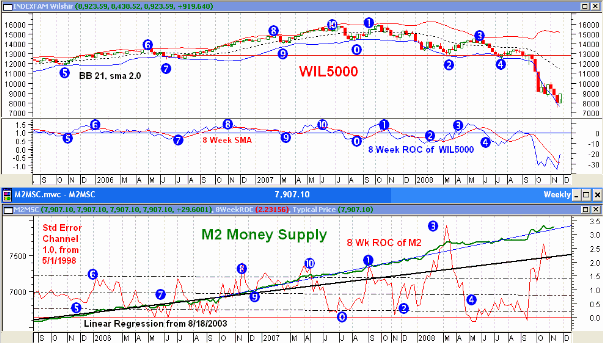
December
Over all years the OTC has been up 62% of the time in November with an average gain of 1.5% second only to January with an average gain of 3.2% and tied for 2nd with April and November. During the 4th year of the Presidential Cycle, December ranks 5th with an average gain of 0.7%, up 55% of the time.
The average month has 21 trading days. The chart below has been calculated by averaging the daily percentage change of the OTC for each of the 1st 11 trading days and each of the last 10. In months when there were more than 21 trading days some of the days in the middle were not counted. In months when there were less than 21 trading days some of the days in the middle of the month were counted twice. Dashed vertical lines have been drawn after the 1st trading day and at 5 trading day intervals after that. The line is solid on the 11th trading day, the dividing point.
The blue line shows the average of all years since 1963 while the green line shows the average during the 4th year of the Presidential Cycle.
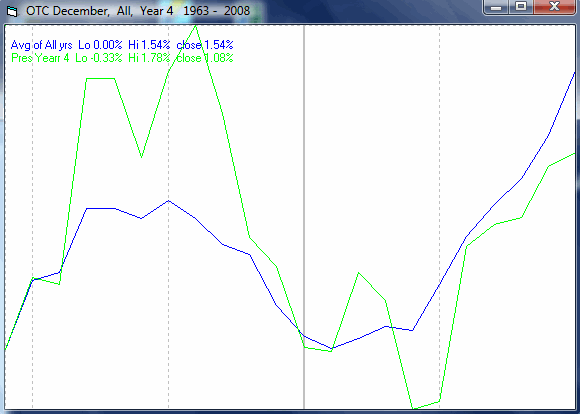
Since 1928, over all years the SPX has been up 74% of the time in December with an average gain of 1.3% making it the best month of the year. During the 4th year of the Presidential Cycle the SPX has been up 80% of the time making December the best month of the year by that measure. The average gain of 1.3% in December is 3rd behind an average gain of 2.8% in August and a 1.7% gain in July.
The next chart is similar to the one above except it uses SPX data from 1928. The average for all years is shown in red while the average for year 4 is in green.

Conclusion
The pattern of a violent rally from the November lows is uncomfortably similar to the rally off the October lows into Election day. I expect the major indices to be lower on Friday December 5 than they were on Friday November 28.
Thank you,
By Mike Burk
To subscribe to this report : http://alphaim.net/signup.html
Gordon Harms produces a Power Point for our local timing group. You can get a copy of that at: http://www.stockmarket-ta.com/ .
Disclaimer: Mike Burk is an employee and principal of Alpha Investment Management (Alpha) a registered investment advisor. Charts and figures presented herein are believed to be reliable but we cannot attest to their accuracy. Recent (last 10-15 yrs.) data has been supplied by CSI (csidata.com), FastTrack (fasttrack.net), Quotes Plus (qp2.com) and the Wall Street Journal (wsj.com). Historical data is from Barron's and ISI price books. The views expressed are provided for information purposes only and should not be construed in any way as investment advice. Furthermore, the opinions expressed may change without notice.
Mike Burk Archive |
© 2005-2022 http://www.MarketOracle.co.uk - The Market Oracle is a FREE Daily Financial Markets Analysis & Forecasting online publication.



